Why Pianos go out of Tune
Sound and sound production
Influenced by the acoustical qualities of the environment in which the piano or grand piano lives, the sound of the instrument is produced by vibrating steel strings, which vibrate via a bridge to the soundboard. The vibrating soundboard surface stimulates a large number of air molecules and the sound becomes audible to our ears. The sounds the instrument produces have a certain frequency (number of hertz) that determines the height of the sound (pitch).
Swelling and shrinking of wood
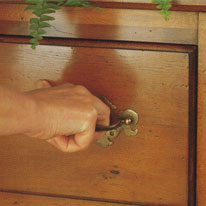
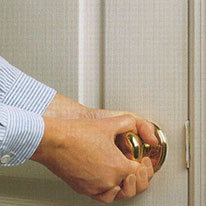
All wood shrinks and swells with humidity changes… even your piano! In the wet season, when humidity levels in the air are higher, you may notice that some of your drawers or doors stick. This is because the woods absorb moisture from the air and swell in the wet season, while they shrink in the dry season. Painted or varnished wood still absorbs moisture, although slower than bare wood.
The rounded varnished soundboard is the single largest piece of wood in your piano. The outer edge of the soundboard is glued to a rim, just like a drum (photo below). The big beams under the soundboard are for structural strength. The cast iron frame is fastened to the rim, beams and pinblock, but does not touch the soundboard. The tuning-pin-block is fastened to the case and bottom of the frame, and together holds the string tension.
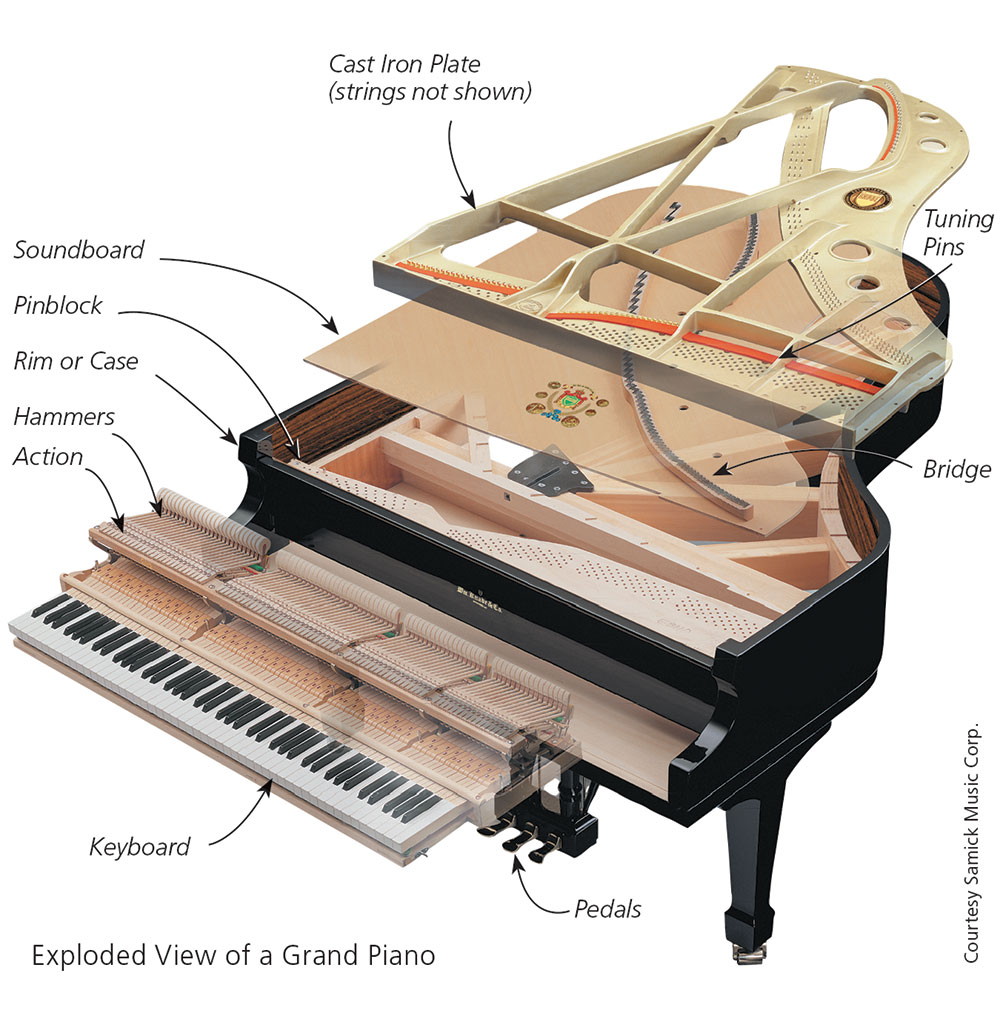
 The bridges of the piano are joined to the soundboard and support the strings. As the soundboard and bridges absorb moisture from the air, they swell, causing the strings to be pushed up to a higher string angle. This puts additional tension on the strings and the pitch is too high (sharp). The whole piano will have gone sharp, but the 3rd and 4th octave will be noticeably sharper again compared to the 1st, 2nd, 5th, 6th and 7th octave. Because the soundboard rises much more in the middle (the 3rd and 4th octave) than near its outer edges, your piano will sound out of tune. It is most noticeable to the ear when an octave is played between the 2nd and 4th octave. If you cannot hear it, play a tenth (an octave + a third, e.g. C3/E4) chromatically up and down the keys, and you will surely notice it.
The bridges of the piano are joined to the soundboard and support the strings. As the soundboard and bridges absorb moisture from the air, they swell, causing the strings to be pushed up to a higher string angle. This puts additional tension on the strings and the pitch is too high (sharp). The whole piano will have gone sharp, but the 3rd and 4th octave will be noticeably sharper again compared to the 1st, 2nd, 5th, 6th and 7th octave. Because the soundboard rises much more in the middle (the 3rd and 4th octave) than near its outer edges, your piano will sound out of tune. It is most noticeable to the ear when an octave is played between the 2nd and 4th octave. If you cannot hear it, play a tenth (an octave + a third, e.g. C3/E4) chromatically up and down the keys, and you will surely notice it.
 In dry weather the reverse happens. The whole piano will have gone flat, but 3rd and 4th octave will be noticeably flatter compared to the 1st, 2nd, 5th, 6th and 7th octave. Because the soundboard flattens much more in the middle than near its outer edges, your piano will sound out of tune. In addition, the strings in your piano vary enormously in length, thickness and tension, and they never retune themselves perfectly and your piano remains out of tune.
In dry weather the reverse happens. The whole piano will have gone flat, but 3rd and 4th octave will be noticeably flatter compared to the 1st, 2nd, 5th, 6th and 7th octave. Because the soundboard flattens much more in the middle than near its outer edges, your piano will sound out of tune. In addition, the strings in your piano vary enormously in length, thickness and tension, and they never retune themselves perfectly and your piano remains out of tune.
Damage caused by the shrinking and swelling of woods in your piano
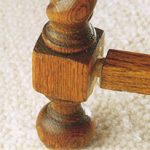
 Glued wooden joints become loose in your furniture and piano when the air in your home becomes drier from seasonal changes or from winter heating. Hundreds of inter-related action-mechanism parts lose their alignment with each other and the strings as hundreds of screws become loose. Frequent changes in humidity levels, which happens all day and every day of the year, with the corresponding shrinking and swelling of the soundboard, will damage the integrity of the soundboard. You will see this damage in the form of compression ridges or cracks in the soundboard. The photo on the right shows the cracked and flattened soundboard of a Bechstein grand piano with the strings and frame removed. Guus van den Braak custom hand-made and fitted a new soundboard to this Bechstein grand piano (see “Restorations”).
Glued wooden joints become loose in your furniture and piano when the air in your home becomes drier from seasonal changes or from winter heating. Hundreds of inter-related action-mechanism parts lose their alignment with each other and the strings as hundreds of screws become loose. Frequent changes in humidity levels, which happens all day and every day of the year, with the corresponding shrinking and swelling of the soundboard, will damage the integrity of the soundboard. You will see this damage in the form of compression ridges or cracks in the soundboard. The photo on the right shows the cracked and flattened soundboard of a Bechstein grand piano with the strings and frame removed. Guus van den Braak custom hand-made and fitted a new soundboard to this Bechstein grand piano (see “Restorations”).
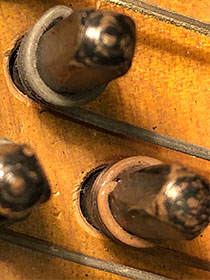 Tuning pins are constantly under stress from high string tension. String tension varies between approximately 75kg and 150kg per string and the total string tension on an average piano is between 18 and 20 ton, but can be up to 27 tons. As the pinblock absorbs moisture in periods of high humidity, it swells, crushing the wood fibres against the pins.
Tuning pins are constantly under stress from high string tension. String tension varies between approximately 75kg and 150kg per string and the total string tension on an average piano is between 18 and 20 ton, but can be up to 27 tons. As the pinblock absorbs moisture in periods of high humidity, it swells, crushing the wood fibres against the pins.
 In dry periods, the wood shrinks away from the pins, loosening the pins, causing the pins to lean over from the high string tension (photo left) and eventually the pinblock to crack (photo right). When pins are loose, they no longer have a snug and tight fit and have lost their resilience. This deterioration compromises tuning stability, the ability to hold pitch, and causes the piano to go out of tune sooner than it normally would.
In dry periods, the wood shrinks away from the pins, loosening the pins, causing the pins to lean over from the high string tension (photo left) and eventually the pinblock to crack (photo right). When pins are loose, they no longer have a snug and tight fit and have lost their resilience. This deterioration compromises tuning stability, the ability to hold pitch, and causes the piano to go out of tune sooner than it normally would.
 Bridge pins are also under constant stress from high string tension. The strings make a zigzag over the bridges to obtain a clear tone. As the bridge absorbs moisture in periods of high humidity, it swells, crushing the wood fibres against the pins. In dry periods, the wood shrinks away from the pins, loosening the pins, causing the pins to lean over from the high string tension and eventually the bridge to crack. This also compromises tuning stability, the ability to hold pitch, and causes the piano to go out of tune sooner than it normally would.
Bridge pins are also under constant stress from high string tension. The strings make a zigzag over the bridges to obtain a clear tone. As the bridge absorbs moisture in periods of high humidity, it swells, crushing the wood fibres against the pins. In dry periods, the wood shrinks away from the pins, loosening the pins, causing the pins to lean over from the high string tension and eventually the bridge to crack. This also compromises tuning stability, the ability to hold pitch, and causes the piano to go out of tune sooner than it normally would.
 Have a very close look at the photos of a two-year old $40,000 grand piano and see how all bridge-pins are loose, have a gap, and show signs of cracking.
Have a very close look at the photos of a two-year old $40,000 grand piano and see how all bridge-pins are loose, have a gap, and show signs of cracking.
When bridge-pins are loose, they no longer have a snug and tight fit and have lost their resilience. When bridge-pins are slightly loose, even when not visible to the naked eye, they cause the strings to have a false beat (a vibrato-like tone). False beating strings cannot be tuned properly and those strings will not sound in tune. This deterioration also compromises tuning stability and causes the piano to go out of tune sooner than it normally would. About 98% of pianos have false beating strings to some extent, usually due to neglect or sometimes due to an inferior manufacturing process.
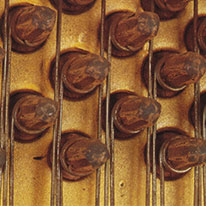 The strings in a piano are responsible for producing the musical sounds. With exposure to high humidity levels, strings become rusted and corroded. Sound distortion and tonal decay is a result of loose tuning pins, loose bridge pins, rusted strings, warn hammers, a damaged soundboard, and worn string-bearing points on the steel frame.
The strings in a piano are responsible for producing the musical sounds. With exposure to high humidity levels, strings become rusted and corroded. Sound distortion and tonal decay is a result of loose tuning pins, loose bridge pins, rusted strings, warn hammers, a damaged soundboard, and worn string-bearing points on the steel frame.
![]()
It is critically important to control the relative humidity in and around the piano to preserve the structural integrity, tone and tuning stability of your piano!

